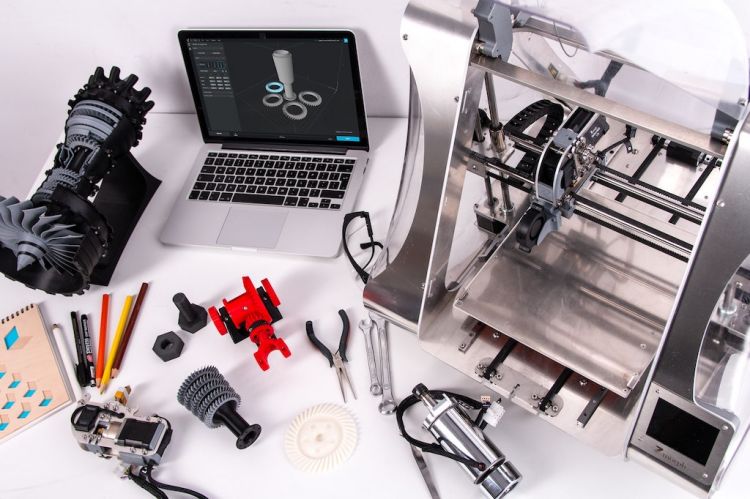The Evolution of the Automation Industry

Innovations in the automation industry, driven by new technology like AI, are transforming how businesses manage repetitive tasks.
Right now, automation can refer to a wide range of technologies — from complex machines like robot arms to relatively simple computer software that automates work like data entry and processing.
These key trends show how the automation industry is evolving right now, and where the industry is likely to go in the near future.
New Types of Robots for Industrial Automation
One of the biggest recent developments in the automation industry has been the evolution of collaborative robots. Sometimes called cobots, these are robots built from the ground up to work alongside human workers. Safety features like force limiters, padded joints and lightweight frames help to prevent common robot-related injuries.
These collaborative robots can perform a wide variety of industrial tasks without requiring the tasks to be fully automated. Many cobots are also built to be as flexible as possible, allowing manufacturers to swap cobots from job to job as needed.
Use cases for these bots include tasks like item picking, drilling, gluing and machine tending, making them effective for miscellaneous industrial tasks that typically require human workers.
Some new cobots are also beginning to take advantage of AI to improve their safety and ability to automate tasks.
Automated Mobile Robots (AMRs)
Mobile robots are also becoming more popular. These are robots that use AI-powered machine vision and navigation tech to move around a facility. They’re capable of automating many tasks that previously required human labor.
Like cobots, they’re designed to work in close proximity with human workers and are built with flexibility in mind — meaning that operators can switch the bots from task to task as business needs change, often with minimal reprogramming.
Amazon is one of the best-known businesses to have adopted these robots so far. In the company’s warehouses, workers use mobile robots to streamline picking and packing orders. The company plans to one day use the robots to fully automate some of its warehouses.
Robot Process Automation for General Business Use
Process automation is a popular automation technique that is used by a wide variety of businesses — from manufacturers to ecommerce retailers to small businesses of all kinds. The technology can simplify a massive variety of tasks, so long as they’re mostly repetitive and don’t require much problem-oriented thinking.
For example, modern robotic process automation (RPA) tools can automate invoice processing, data migration and even fraud detection.
If you can break the task down into a set of rules, no matter how complex, you can use RPA to automate it.
This can save a serious amount of time — according to one IDC study, the average data worker loses as much as 30% of their time on finding, preparing and protecting data. RPA tools that can automatically perform these tasks will help data workers get analysis and other more important tasks sooner.
For small businesses and enterprises that struggle with administrative overhead, RPA is probably one of the most useful kinds of automation — especially as the tech behind it becomes more and more sophisticated. New RPA tools are capable of increasingly complex automation.
For example, natural language processing (NLP) is a kind of AI tech that allows computers to break down and understand plain written language.
RPA platforms with NLP can sort through documents like invoices, pricing inquiries and customer support logs to extract key information. With this info, it may be possible to automatically generate estimates for customers, bill clients and condense lengthy records into simple notes.
AI, IoT and Algorithmic Automation
AI is likely to make automation even more powerful. Artificial intelligence is an excellent tool for finding subtle patterns in extremely large data sets — data sets that may be too large for a team of data scientists to process on their own. This ability also makes it possible for the technology to power predictive algorithms that use existing information to forecast future events and trends.
For example, predictive maintenance uses AI and data from machine sensors to predict when machines will need maintenance.
The maintenance strategy provides an upgrade to the current gold standard for maintenance, preventative maintenance. It can help businesses save money and avoid downtime, which can be extremely expensive when managers don’t see it coming.
These AI algorithms take advantage of the growing number of internet of things (IoT) devices. IoT technology, like internet-connected temperature sensors or air quality monitors, can be used for a wide variety of automation purposes.
For example, a business may be able to fully automate a building’s HVAC system with AI and IoT, automatically adjusting building temperature or alerting managers when air quality levels dip and filters need to be changed.
Other AI tools leverage new business platforms, like sales management technology that automatically records and organizes sales data for processing.
With the right information, businesses can use AI to create more accurate demand forecasting tools. These tools can help businesses to predict seasonal demand changes, demand spikes and other changing market conditions.
As customers come to expect faster turnaround times on new orders and as demand grows more volatile, these tools may become invaluable for businesses.
Modern Automation and the Future of the Industry
New automation technology is transforming how businesses automate repetitive and dull tasks. This tech is built for both heavy industry and general business use, meaning that almost every business can take advantage of recent innovations.
Future automation technology is likely to make robots and IoT technology even more useful for businesses. Self-piloting robots can help to streamline a wide variety of industrial work, and IoT devices may help businesses gather data that’s essential for creating predictive algorithms.
